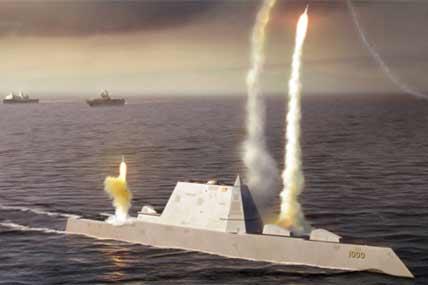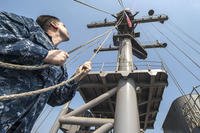The Navy plans to distribute more weapons and offensive firepower throughout the surface fleet as part of a new strategic approach designed to address a fast-changing global threat environment, senior service leaders said Jan. 13 at the Surface Navy Association National Symposium in Arlington, Va.
"We're going to up-gun as many existing platforms as we can to achieve more total lethality," Vice Adm. Thomas Rowden, commander of Naval Surface Forces, said at the symposium.
Referred to as "distributed lethality," the new strategy is aimed at upgrading existing weapons and adding weapons to a wide array of platforms, including destroyers, cruisers, amphibs, carriers and the Littoral Combat Ship variant called the Small Surface Combatant, Rowden explained.
"The first thing we have to do is look at the weapons that currently exist and see what modifications we can make to those systems to increase our offensive punch," Rowden said at the symposium. "We are looking around the fleet to target lethality upgrades wherever we can."
As part of a discussion of this new strategy, Rowden said the Navy plans to acquire a new, offensive long-range anti-surface weapon that puts U.S. Navy surface forces back on the positive side of the range equation with respect to potential adversaries.
The Navy is already working on developing or acquiring a new offensive long-range weapon for the LCS and the Small Surface Combatant.
However, alongside its efforts to arm the LCS and Small Surface Combatant, the Navy is interested in new offensive weaponry options for destroyers, amphibious ships and other platforms, Rowden explained.
"We need to think about this weapon as something we can back fit throughout the DDG fleet. We'll have between 30 and 33 amphibious ships throughout the life of our current 30-year shipbuilding plan. What's to keep us from equipping these ships with an offensive SUW [surface warfare] weapon?" Rowden asked.
The Navy has been looking at long-range missile options for the LCS for months now. Last September, the Navy test-fired a Norwegian long-range precision strike missile from the deck of the LCS.
The missile tested is called The Kongsberg Naval Strike Missile. It is a long-range precision strike missile currently used on Norwegian Nansen-class frigates and Skjold-Class missile torpedo boats. The missile is also used by the Polish Coastal Missile Division, Navy officials said.
The Navy is also looking at a Raytheon-engineered extended-range variant of the Griffin missile that triples the range of the weapon and adds infrared imaging guidance technology.
The existing Griffin missile, which can be launched from the air, sea or land, uses GPS and laser guidance technology. The new variant now being tested allows infrared technology to work in tandem with laser designation, Raytheon officials explained.
Beyond individual missiles, the new overall strategy is aimed at distributing new, existing and upgraded weaponry across the fleet to hold potential adversaries at risk and give fleet commanders more offensive combat options.
"It is about taking the budget that we have and making everything that floats more lethal," Rear Adm. Peter Fanta, director of the surface warfare division, said at the symposium.
Moving Beyond the Post-Cold War Era
The new strategy hinges upon the realization that the U.S. Navy no longer enjoys the unchallenged maritime dominance it had during the post-Cold War years, Rowden explained.
During the years following the collapse of the former Soviet Union, the U.S. Navy shifted its focus from possibly waging blue-water combat against a near-peer rival to focusing on things such as anti-piracy and Visit, Board, Search and Seizure, or VBSS, techniques.
"The wall did fall and the world was left with one dominant naval power unchallenged at sea and unstoppable as a power projection machine. We got good at anti-piracy and VBSS because there was no threat," Rowden said. "There was no one who could challenge us at sea. The lack of a blue-water threat colored the manner in which we conducted campaign analysis."
Just prior to these developments, the Navy had been focused on major offensive tactics and a range of major combat possibilities during the height of the Cold War, Rowden explained.
The size of the Navy fleet during the 1980s, for example, was much larger than it is today. The Navy operated nearly 600 ships in the late '80s.
"The Navy that stood down the Soviets was a well-balanced force capable of sustaining operations. It was a Navy that was equally adept at sea control as it was at strike. Carrier strike group missions were distributed broadly among the assets available, with surface ships capable of targeting and destroying enemy ships over the horizon," Rowden said.
These historical circumstances have informed the calculus regarding the new strategy, an approach built upon the recognition that the U.S. Navy no longer maintains an uncontested global maritime dominance in the ways that it did following the Cold War.
"We are challenging our own assumptions and re-thinking our role in naval surface warfare. We are adapting to a changed environment. We are responding to national strategic imperatives and we are going on the offensive," Rowden said.
-- Kris Osborn can be reached at Kris.Osborn@military.com.





























